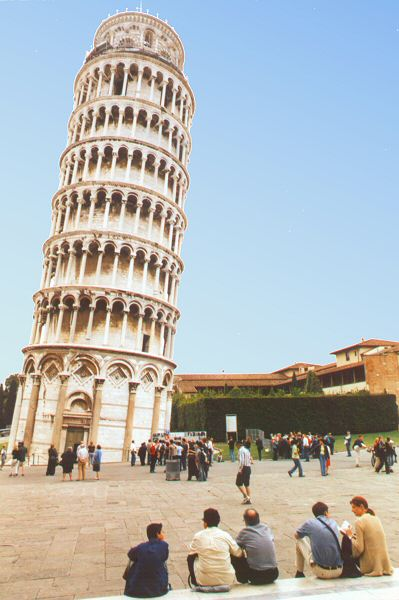Two buildings are pictured below. Both of them are famous, but for very different reasons.
Construction on the Leaning Tower of Pisa (pictured left) began in 1173, and the tower began to sink as second floor was being built in 1178. The reason was pretty simple: the 3-meter foundation was placed on unstable soil.
The construction was halted for about 100 years due to war, which allowed the soil to partially settle and saved the tower from collapse. Engineers began building again, making the rooms on one side of the tower taller than the other. This gave the Leaning Tower of Pisa a curved shape, but it didn’t solve the problem—the lean of the tower kept getting worse, making it a danger to the public. Numerous attempts were made to stabilize this structure over the years—some of which actually worsened its condition.
It took over a decade of work to get the tower stabilized. The final project began in 1990 and was completed in 2001. Seventy tons of soil had to be removed in order to adjust the angle of the building and keep it from falling over.
The Taipei 101 Tower, located in Taiwan, is an astounding 1,667 feet tall. The building was the tallest in the world upon its completion in 2004.
The foundation of the Taipei 101 Tower is just as impressive as the building itself. The soil directly underneath the tower is actually inadequate to support the massive structure. But geologists discovered a layer of solid bedrock about 260 feet underneath the soft earth. The builders placed 382 concrete piles deep in the soil—each pile weighing somewhere between 1,100 to 1,460 tons. They poured 30,000 yards of concrete on top of these piles to form the foundation of the Taipei 101 Tower. Creating this foundation took 15 months.
The Leaning Tower of Pisa, built on a poor foundation, began to sink after only the second floor was built. The Taipei 101 Tower, built with a proper foundation, has 101 floors and has easily withstood both earthquakes and typhoons. One tower is famous for being an architectural blunder; the other stands as a testament to modern ingenuity. The right foundation makes a big difference!
Jesus used the foundation analogy in one of his most well-known parables:
“Everyone then who hears these words of mine and does them will be like a wise man who built his house on the rock. And the rain fell, and the floods came, and the winds blew and beat on that house, but it did not fall, because it had been founded on the rock. And everyone who hears these words of mine and does not do them will be like a foolish man who built his house on the sand. And the rain fell, and the floods came, and the winds blew and beat against that house, and it fell, and great was the fall of it.”
Matthew 7:24-27
This parable is part of a message most commonly referred to as the Sermon on the Mount (Matthew 5-7). Multitudes had come to hear this amazing teacher and worker of miracles. Jesus shocked His listeners by telling them that superficial self-righteousness was not acceptable to a Holy God (Matthew 5:20). He went on describe a way of life that can only come from a renewed heart.
Jesus ended His sermon with an illustration that simultaneously delivers a promise and a warning. Those who believe and apply what they hear will benefit eternally. Those who disregard His message do so at their own peril.
Think about it this way: according to Jesus, we are all building something–our lives. Every decision you make, every relationship you begin or end, every habit you develop–it all ultimately adds up to the sum that is your life.
But what we build is only as good as the foundation it is placed upon. And the right foundation, according to Jesus, can be summarized in one word: obedience.
Jesus is not saying that we earn our way into heaven by following His commands. Instead He means that those who have truly put their faith in Him will be inclined to obey Him. None of us obey perfectly, but trusting Him as Savior brings a new nature and a desire to make Him Lord of our lives.
Jesus urged his listeners to choose their foundation carefully. Not all foundations are equal, and not all will survive the test. And let’s be clear: regardless of what/where you build, your foundation will be tested.
Trials, for example, will test your foundation. All of us will inevitably face a severe test in our lifetime. It may be something like the death of a loved one or a life-threatening illness. Life will eventually take something that’s dear to us, forcing us to face the fleeting nature of anything we cling to in this all-too temporary world.
Time will also test our foundation. The days and months will pass by relentlessly. Blink and a decade will pass by. Blink again and you’ll be in the final years of your life. We will either look back on a life that was well-lived through obedience to Christ or on a series of regrets, missed opportunities, and wasted time.
Finally, and most importantly, eternity will test our foundation. One day our time on this earth will come to an end. We will face God and enter into eternity as people who have prepared wisely or as those who have lived foolishly.
Following Jesus, just like building a solid foundation, is not easy. But there’s something much more difficult than following Jesus: the consequences of disobedience. Notice how Jesus describes the fate of the foolish builder’s house in verse twenty-seven: “and great was the fall of it.”
You have a choice. You can be like the wise man who built his house on a solid foundation or like the foolish man who built on the sand.
Choose wisely!
Pictures of The Leaning Tower of Pisa and the Taipei 101 Tower are both courtesy of Wikimedia Commons.




